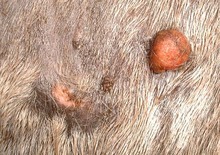Squamous Cell Carcinoma is one of the most common tumors in horses but is more common in anatomic locations other than the bladder, such as the external genitalia, the skin, the stomach, and the eye.

Carcinoma of skin of horse
Squamous Cell Carcinoma is one of the most common tumors in horses and is more common on external genitalia, skin, eyes, and in the stomach than in the bladder.
© 2012 by Malcolm Morley
Presentation and diagnosis of SCC vary with the location. Masses on the skin, genitalia, and ocular structures are grossly evident, and diagnosis can easily be made using biopsy and histopathology.
When a 14-year-old Hanoverian gelding was brought into a clinic and evaluated after a 10-week history of occasional straining during urination and dark red urine production after exercise, the physical examination findings were within normal limits. Ultrasonography found no abnormalities in the kidneys or bladder, but a freely voided urine sample revealed an elevated protein concentration and few red blood cells.
Vitamin C supplementation was suggested to acidify the urine, as was provision of a salt block to encourage water intake.
The horse returned 6 weeks later for further evaluation. The urine had remained discolored, and the horse was hesitant to move forward under saddle. The vital parameters were within normal limits. The results of physical and lameness examinations were normal. The horse was ridden for over an hour to mimic home observations and to demonstrate urine abnormalities after work.
Urination after exercise demonstrated frank blood at the end of the urine stream. Transrectal ultrasonography of the apex of the urinary bladder revealed a soft tissue mass attached to and within the bladder wall.
The horse was sedated using detomidine, and cystoscopy showed a large, irregular-surfaced mass disrupting the mucosa of the bladder at the apex. The mass was ulcerated, pink, approximately 10 cm in diameter, and attached to and within the bladder wall. The remainder of the bladder had no obvious abnormalities.
The ureters were of normal size and appearance. Because of the apparent focal characteristic of the mass, partial cystectomy was recommended, and the horse’s owner elected it.
Primary urinary bladder neoplasia in horses is uncommon. Transitional cell carcinoma has also been described in horses. Lymphosarcoma, hemangiosarcoma, and melanoma rarely metastasize to the bladder.
Horses with bladder tumors typically have signs of weight loss and hematuria and may also have pollakiuria and stranguria. The mass may be palpated on rectal examination and can be confirmed by transrectal ultrasonography and cystoscopy.
Urinalysis usually shows hematuria and occasionally reveals exfoliated neoplastic cells. Historically, treatment of bladder neoplasia includes surgical excision combined with topical chemotherapy.
Horses with gastric SCC present with clinical signs including anorexia, emaciation, colic, dysphagia, and neutrophilia. Either gastroscopy with biopsy and histopathology or exploratory laparotomy can yield a diagnosis in most horses.
Management of equine SCC depends on the location and size of the tumor, the available equipment, and the cost of treatment. With penile and preputial SCCs, tumor grading can help select the treatment and determine the prognosis.
Complete phallectomy and preputial resection and removal of lymph nodes can result in the lowest rate of tumor recurrence compared with other therapies, such as cryosurgery and partial phallectomy and sheath ablation.
Potential therapies for ocular SCC include surgical resection, strontium 90 irradiation, interstitial radiotherapy, external beam radiotherapy, radiofrequency hyperthermia, intratumoral or topical chemotherapy, carbon dioxide laser ablation, and cryotherapy.
Adjuvant radiation therapy for ocular and adnexal SCCs has produced a much lower recurrence rate than that of tumors treated without it.The high risk of recurrence makes successful therapy difficult.
Recently, NSAIDs have been shown to (1) reduce the recurrence rate and stabilize or reduce the size of tumors of the colon and (2) decrease angiogenesis in tumor models.
Cyclooxygenase-2 (COX-2) is an inducible enzyme involved in prostaglandin production during pathologic events. COX-2–derived prostaglandins have been linked to tumor growth, metastasis, and angiogenesis.
Studies show that many types of tumors including some SCCs, upregulate COX-2 in their tissues. Several studies have demonstrated that equine SCCs have increased expression of COX-1 and COX-2. This has led to some new therapies for equine SCC. Piroxicam, a nonspecific COX blocker, has been used to successfully treat canine SCC.
Piroxicam may still be a valid treatment for horses because it reduces direct DNA damage, prevents malignant transformation of cells, and stimulates immunity by reducing prostaglandin E2 production by neoplastic and other effector cells. Piroxicam also suppresses cellular proliferation by reducing prostaglandin E2 production, inhibits angiogenesis, interacts with growth factors, and induces apoptosis.
Anecdotal and clinical evidence has indicated that piroxicam alone or with adjunct therapy, such as surgical excision or administration of chemotherapeutic agents, can provide long-term control of SCC in horses.
Further research is needed to fully assess the long-term and adverse effects of piroxicam in horses, but this drug may have fewer gastrointestinal and renal effects than other nonselective NSAIDs, as suggested by use in dogs.
The long-term prognosis for horses with SCC depends on the tumor location. As demonstrated in this case, even with aggressive treatment such as full resection and administration of COX-2 inhibitors, recurrence is likely.
With superficial tumors affecting the eyes, external genitalia and skin, resection and intra-lesional therapy are easier to perform, possibly improving the likelihood of successful therapy. Diagnosis and treatment of SCC such as those in the bladder and abdominal areas are associated with more difficulties, which can lead to a poor prognosis.
